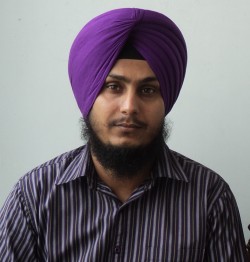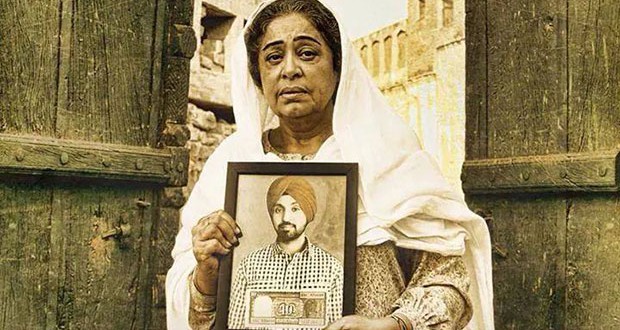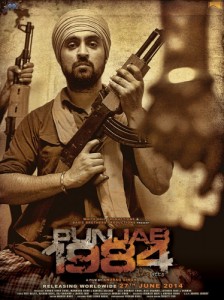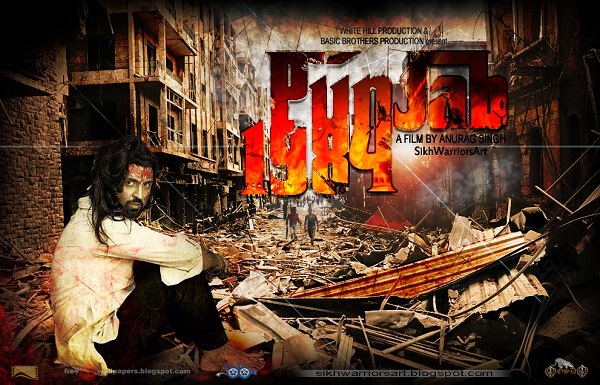Articles/Opinion
Punjab 1984 movie – Why do I have objections to it?
July 2, 2014 | By Parmjeet Singh

Author: Paramjeet Singh
A new Punjabi movie, “Punjab 1984” starring Diljit Dosanjh was released last Friday. The movie was directed by Anurag Singh who claimed that his movie was “not-political”.
The movie has evoked mixed reactions from the audience. Diljit’s fans, mostly teenagers are praising the movie and some even went on to say that now they know the “facts” about 1984 as these were shown in the movie.
But on the other hand many Sikh circles have criticized the movie for a distortion of the facts, for being influenced by State propaganda and for it’s negative portrayal of the Sikh struggle.
The debate between the two sides is going on over social media sites.
If we are to talk about the movie itself, it is the story of a mother whose son was picked-up by the police at the behest of a relative with whom the family had a land dispute. The mother had an almost unending wait to see her son again. At the same time it’s the story of a son who does not want to return home secretly in the night just because of the threat of police persecution, rather he is determined to return to his home openly, in broad day light and with honour.

The story begins when the father of Shiva (played by Diljit Dosanjh) was killed during “crossfire” in the parikarma of Darbar Sahib between the Indian army and Sikhs in June 1984. Shiva’s father was termed as a terrorist and his body was disposed of by the state.
Shiva’s family, in the movie, had a land dispute with one of their relatives who conspired with the police against Shiva. One day a police inspector, Rana picked up Shiva under the pretext of having committed a militant action.
Shiva’s mother made every attempt to find her son. She even suffered the wrath of the police officer Rana when she was telling her story to a journalist. A Hindu friend of Shiva defied all threats to help Shiva’s mother find her son.
A human rights lawyer was shown as having albums of those killed by the police.
After arrest, Diljit escapes from police custody with two others – one who was arrested for writing revolutionary poems while another was arrested because he had beaten up the son of police personnel for eve-teasing his girlfriend.
The escapees join a militant group, whose leader used to talk about the formation of Khalistan by use of the gun, despite his own character not being up to mark.
The new “recruits” take training in Pakistan and return to Punjab to undertake “actions”.

Punjab 1984
They kill a senior police officer. Shiva (Diljit) agrees to do this action, less because of his concern for the movement and that the police officer was responsible for fake encounters, more for personal reasons, that the police officer was a senior of Rana (the police officer who had picked up Shiva).
Shiva (Diljit) then plants a bomb in a bus to kill innocents but when he sees his mother travelling in the same bus he runs fast to take the bomb out of the bus and condemns such type of “actions”.
His group leader sends some other persons at the behest of Pakistan’s agents to kill Hindus. They pull Hindus out of a bus, including Shiva’s friend and kill them all.
Shiva kills his family rival who was trying to till his land.
A “Khalistani” leader who had justified the killings of Hindus in a meeting (thought he was shown not responsible for that) was had killed by the militant group leader that Diljit belonged to.
Diljit’s associate was killed by his group leader’s men, but Diljit survived the attack and killed his militant group leader and the corrupt politician head who controlled him.
Then Shiva (Diljit) challenges Rana (police inspector), kills him and returns to his village whilst raising “Jaikaras” but upon reaching the doors of his house another cop kills him while terming him as a bloody “terrorist”.

At the end of the movie, families of those subjected to enforced disappearances in Punjab were shown on screen holding photos of victims. Brief details were also extended about victims and their families.
This is a tragic-drama sort of movie. Many movies dealing with family rivalry, police atrocities, corruption of politicians were made in the past.
So now the question is why could one have objections to this movie?
Here are some issues because of which I have problems with this movie:
(1) Attempt to detach “Punjab 1984” trauma from the Sikh memory: “1984” has a special meaning for the Sikhs. It has become a symbol of the trauma suffered by the Sikh nation. Sikhs regarded the attack by the Indian army at Darbar Sahib Amritsar in June 1984 as the “ghallughara”. The event holds the status of cultural trauma for the Sikhs. For the last three decades there was a flood of state propaganda to wash away June 1984 from the Sikh memory, but not only did the Sikhs remember the trauma of 1984, they also tried to establish their own narrative about this trauma.
Now we are standing three decades on and a new generation of Sikhs has grown up. These youngsters did not experience the events of 1984 but they feel attached to those events. They are in search of matter to understand these events. Books, audio-visual (lectures, talks, interviews), social media discussions help them to have that understanding.
Mass-media and the cinema are very powerful mediums. It gets the viewer involved in the story and leaves an impact on his/her feelings.
My first objection to Punjab 1984 is that it attempts to detach the symbolism of Punjab+1984 from the trauma suffered by the Sikhs.
After 30 years, even state propagandists find it hard to boldly justify their (mis)deeds of that time, therefore a new interpretation is being forwarded that the people of Punjab were crushed between two wheels – terrorism/militancy AND state repression. The movie is clearly along these lines.
Two thing need to be specifically mentioned in this regard:
Firstly, no one had earlier portrayed the events of June 1984 on the big screen, especially what happened inside the Darbar Sahib complex. But this movie did it although in a very small part and the argument could be put that it was just to the extent that was connected to the story of Shiva (as his father died in that scene, refer earlier in this write-up). But my concerns are with what “impression” that scene leaves? Innocents being killed in the cross fire – isn’t that an impression about the events of June 1984 that the state wants to leave?
Secondly, the movie is plotted in an entirely different ground than that of “Punjab+1984” and some loose rings are inserted in to the story to make it appear that it was connected to “Punjab” and “1984”. These rings are far away from the facts. I think many would agree with me that the title “Punjab 1984” was given just to market the movie in a more powerful way.
I agree to a caller on Qaumi Awaaz radio that if it really was a movie presenting the tragedy of a concerned mother and her son, a better title for the movie would have been “Udeek – ummran ton lammi” (Wait – longer than lives).
That being said, it’s not my concern to make suggestions to the makers, I simply want to assert my point that the movie’s plot was independent of “Punjab+1984” and that the title appears to be nothing more than a good marketing strategy.
Poor and negative portrayal of the Sikh movement:
All of the scenes related to the Sikh militancy give the following impression: there was no ideological commitments of those joining the militancy after the attack on Darbar Sahib and the Sikh genocide of 1984; further still, that most had joined for personal reasons.
A reviewer went on to justify it all in the following words:
“Punjab 1984 isn’t a propaganda film for the Khalistan Movement, nor should we have expected it to have been. That having been said, I believe the film is positive towards the Movement and Daljit’s character, Shivjit Singh (Shiv) is a strong protagonist.
Like the main character in the film, many of the young men who joined the Movement were initially not particularly ideological or often even all that religious. They were pushed into taking up arms by circumstances and the fact that there were few alternatives available to them.
The story in Punjab 1984 is one that happened all across Punjab. Family disputes, land disputes and other business disputes became thrown into and interwoven with the ongoing insurgency. Some people joined a Jathebandi to ensure their security or because a rival had joined another Jathebandi. In many disputes about money or land, one side paid the police to frame their rivals in order to get rid of them.” (excerpt from Simran Kaur’s review – “Punjab 1984: An Opportunity for Thought & Reflection” published by Sikh24).
I apologise for the long quote above but it perfectly reflects what was shown by Anurag Singh (writer-cum-director of Punjab 1984) in his movie. As readers can see, the author of the above review went on to justify everything in the movie (especially arguments regarding those joining the movement due to personal reasons, goon elements, corrupt politicians etc.) saying it had all existed, but at the same time ignoring the fact that there was another side of the picture as well, one that Anurag hid (it’s not simply that he did not merely present it).
There are living examples of many prominent leaders/ activists of the movement who took up arms out of existential concerns of the Sikh nation and not because of fear of police torture or family rivalry.
I remember that after watching a special screening of “Sadda Haq” in an Amritsar hotel, former militant Ranjit Singh Kukki Gill had clearly said in his address that they had not taken up arms because of fear of police torture nor because of any personal rivalry. According to Kukki Gill it was a natural response to a call of their consciousness after witnessing the attack on Darbar Sahib.
Second point in this regard is that:
What overview does the movie present about the Sikh struggle? Many may argue that the movie was not about the militant movement therefore it is not necessary to get supporters of the Sikh militant movement to agree to the movie.
But the point of concern is that the movie is not so remotely connected to that time period which could make this argument acceptable. The movie presented an overview of militancy in the Punjab – scenes related to the Sikh militant movement in the movie present only the image of the struggle as mindless, violent and cruel terrorism that was being fueled by some self-interested politicians.
It’s a blatant rejection of the idea that the Sikh militant movement was the response of the Sikh nation against the Indian state’s attack to crush the Sikh culture and identity.
About “suggestions” to digest it all:
Many are suggesting that Sikhs digest it all because the movie was based on the tragedy of a mother and a son. Others are advocating such digestion by forwarding an argument that the movie was very sound from purely technical and acting aspects (they even compare it with the “poor” acting and technical aspects of Kaum De Heere).
Just think of that – presenting a “family tragedy” or “technical/acting” aspects as more powerful than the “trauma of a nation”(!)
At the expense of repetition I want to say that I had no objections to a film based on a mother-son tragedy, family rivalry, police atrocities, or the corruption of selfish politicians; but I do object to this movie because: despite being plotted in an entirely different ground it has used the powerful symbolism of “Punjab 1984” apparently for commercial interests; secondly, it attempts to detach the symbolism of “Punjab 1984” from 1984 trauma suffered by the Sikhs; thirdly it transmits only that much information about 1984 and post-1984 which strengthens the state-sponsored symbolism of “dark-times” to refer to the events of 1984 and the aftermath; and lastly it is a negative portrayal of the Sikh struggle.
The impact is clearly visible: a teenager in his response to the movie (available on YouTube | regret that I don’t have the url now) said: “Kaale daur di scahai dikha ditti” (it shows the truth of dark days).
“Attvaadian ne aven taan hathyar nahin c chukke”, (extremists/ terrorists had taken up arms for some reason (due to police atrocities?) said another.
“बड़े पर्दे पर दिखा पंजाब के काले दौर 1984 का सच”, reads a headline by Amar Ujala.
To Get Sikh Siyasat News Alerts via WhatsApp:
(1) Save Our WhatsApp Number 0091-855-606-7689 to your phone contacts; and
(2) Send us Your Name via WhatsApp. Click Here to Send WhatsApp Message Now.
Sikh Siyasat is on Telegram Now. Subscribe to our Telegram Channel
Related Topics: Diljit Dosanjh, Punjab 1984 Movie, Punjabi Movies




